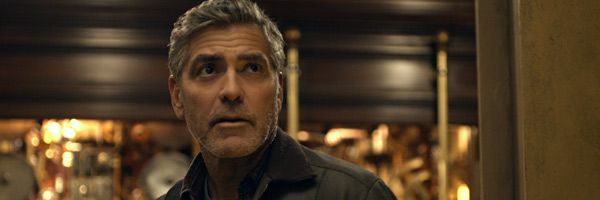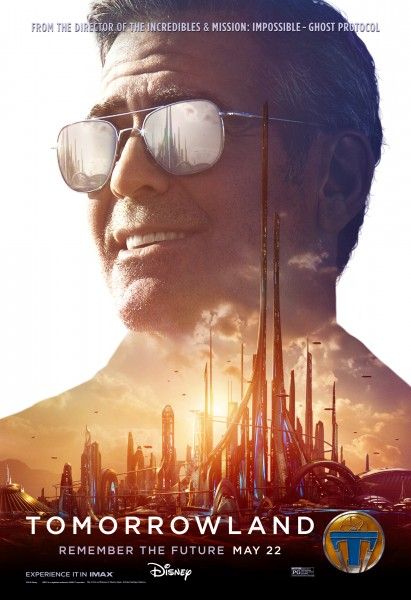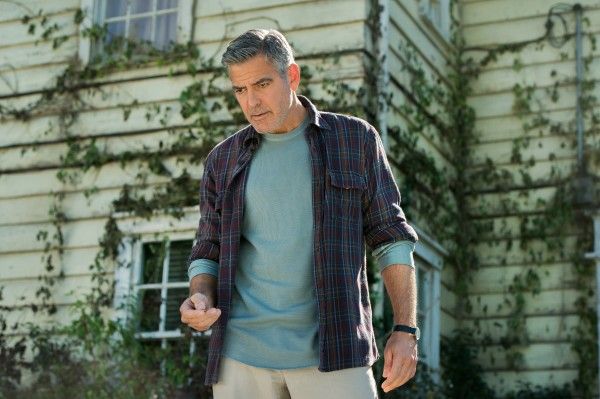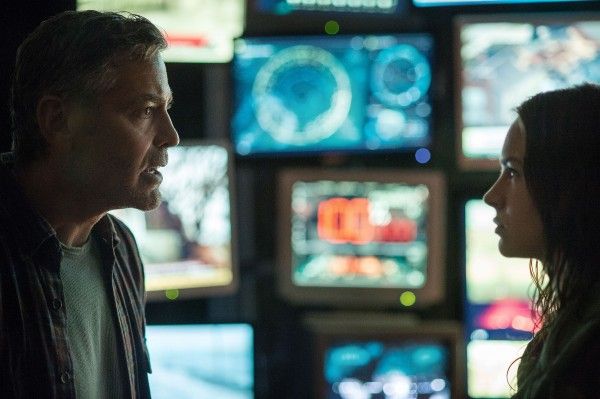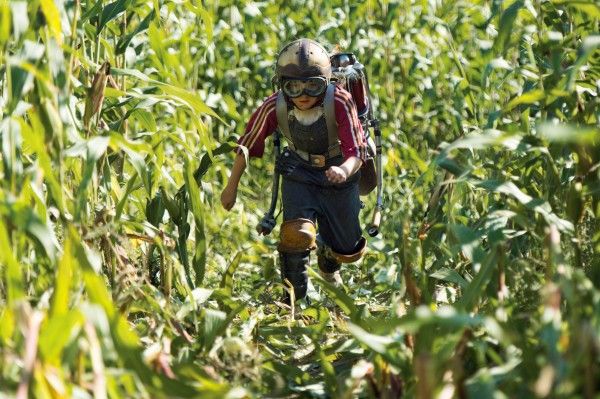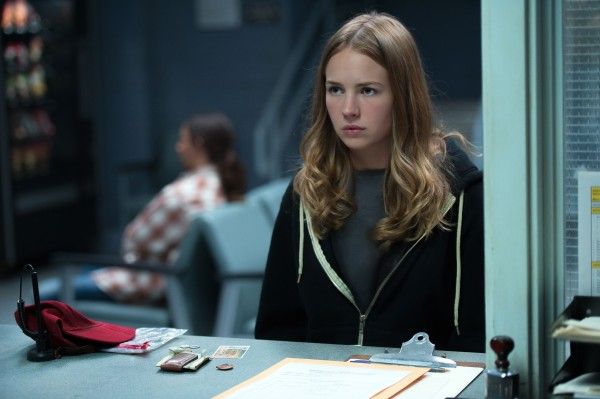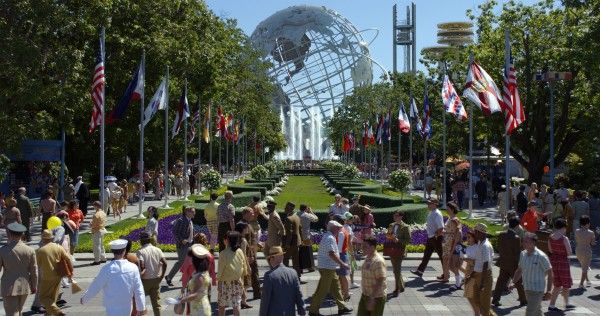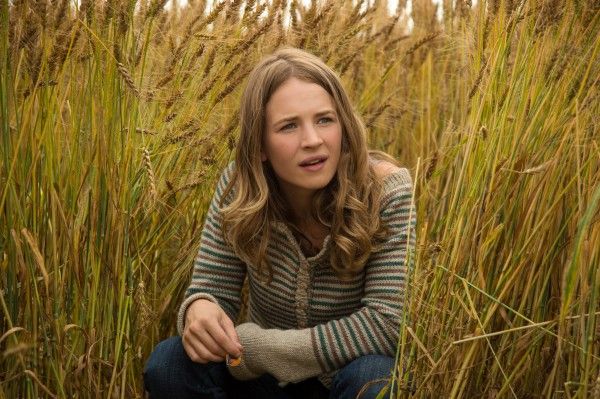Being told that it’s up to you to change the world would be a daunting task for anyone. In Tomorrowland, jaded former boy genius Frank Walker (George Clooney) is bound by a shared destiny with bright, optimistic and curious teen Casey Newton (Britt Robertson), and the two have been tasked with a dangerous mission to unearth the secrets of a mysterious and magical place of hope and wonder, that is somewhere in time and space, outside of our realm.
During a conference at the film’s press day, actor George Clooney, director/producer/co-writer Brad Bird and co-writer Damon Lindelof talked about the origin of this idea, how bold it is for Disney to be willing to do a big summer film that isn’t a sequel or something based on a comic book, why it was important for this story to have a sense of hope, the role NASA played in the production, that everybody should do their part in making the world a better place, the influence of Walt Disney, possible theme park plans, and Clooney’s secret rapping skills.
Question: Damon, this film originates from a series of discussions that you had with people at Disney. What were those discussions, and how did this film come out of them?
DAMON LINDELOF: I was having a lunch meeting with Sean Bailey, who’s the president of production at Disney, and we were talking about the Marvel movies, which we’re both fans. He said that they had a number of fantasy princess movies in the pipeline at Disney, and he just wondered what a Disney movie should be. I said to him, “I don’t know what it’s about, but I’d want to see a movie called Tomorrowland.” And that was the beginning of this whole adventure. For me, I’ve always been really interested in the future, and I feel like all of the movies that I’ve been exposed to, over the course of the last 20 to 30 years, have shown me a future that I don’t really want to be living in. It’s cool to watch, with teenagers trying to kill other teenagers, and robots eradicating mankind, or just apocalyptic wastelands populated by Charlize Theron. They’re all great, but what about that other future? And is there a way to tell that story? And I was really interested in the history of Disney, with the Imagineers and the theme parks, in particular, as it related to the World’s Fair.
Brad, what was most important for you to add to this whole project, once you came on board?
BRAD BIRD: I don’t know. I was just happy to be asked to join. No. I was inspired by the idea, and I was an admirer of Damon’s work. He did a little uncredited work at the very end of Mission: Impossible, and I asked what he was doing next, during that time. He mentioned this idea, and I was immediately hooked.
George, at the heart of this movie is a really big and powerful idea. You’ve made a lot of bold films in your career, including some very political ones, but would you agree that this is right up there, as far as being quite bold?
CLOONEY: Putting me in a summer movie is a very bold thought. First and foremost, I think it’s a really bold thing for Disney to be willing to do a film that isn’t a sequel and isn’t based on a comic book. They’ve truly invested in a summer film of this ilk. When Damon and Brad showed up at my house, they said, “We’ve got a part that we’ve written for you.” And then, I opened up the description of the character and it said, “A 55-year-old has-been,” and I was like, “Hang on a minute! Which part am I reading for?!”
BIRD: It said “genius.”
CLOONEY: It said, “Former boy genius, who’s gotten bitter in his old age.” You turn on your television set and it’s rough out there. It’s not fun. That can really wear on you, after a period of time. We see generations now feeling as if they’re hopeless, in a way. And what I love about this is that it speaks to the idea that your future is not pre-ordained or pre-destined. If you’re involved, a single voice can make a difference, and I believe in that. I love the idea that there’s still so much that we can all do to to make things better.
Having grown up in the Cold War era, do you feel like this reflects the struggle that you personally experienced, in feeling that dread, but also still feeling hope?
CLOONEY: Growing up during the Cold War period, I always found that, although we always thought that the world would end in some sort of nuclear holocaust, at some point, everybody was pretty hopeful. There were an awful lot of things going on that you felt you could change. I grew up in an era where the power of the one really did feel as if it mattered. We had the riots that are reminiscent of the things that we’re looking at today, but we had the Civil Rights movement, and Vietnam, and the women’s rights movement, and all those things that you felt you could actually have some part of changing. If you look at those things that changed, in the ‘60s and early ‘70s, individual voices did make a huge difference. It wasn’t governments doing it, necessarily. So, I didn’t ever have that great disappointment in mankind. I always felt that it was going to work out, in the end, and I still feel that way. And so, what I loved about the film was that it reminds you that young people are not born or start out their lives cynical, angry or bigoted. You have to be taught all those things. I watch the world now and think, “ell, I see really good signs from young people out there, and I feel as if the world really will get better.” I’ve always been an optimist. I’m a realist, but I’m an optimist about it. And I really related to the film because I thought Brad and Damon wanted to tell a story that is entertainment, first and foremost, but hopeful.
Brad, how did NASA play a role in the production, in its symbolization of hope and optimism?
BIRD: I remember the moon landing, and I remember how that felt. I was actually in the air when they were about to get out on the surface. We were flying in from Denver and I was like, “I’m going to miss it!” Fortunately, there were some technical errors, and we ran through the airport to the nearest TV monitor. There were 400 people, just packed in and watching when Neil Armstrong set foot on the moon. Everybody just went, “Whoo-hoo!,” and that feeling has never left me. When we were first planning the movie, Damon and I were at Disney while the space shuttle (Endeavour) took it’s last circle over L.A. Everybody came out and watched it, and there was this weird feeling of pride mixed with great sadness about, “We’re not doing that anymore. Why aren’t we?” So, the chance to shoot at NASA was fantastic. We were on this launch pad, where so many noble journeys started, and we got to watch a launch from the launch pad, which was one of the coolest moments on the film. We can spend our energy creating ways to kill each other, or we could do that. I think that’s a lot more interesting.
Disney’s great at creating movies that are tied into attractions at the theme parks. Is there a Tomorrowland attraction in the works for Disneyland?
BIRD: George is pitching jet packs. He wants everyone issued one, and they could fly around the park.
CLOONEY: It’d be a great ride.
BIRD: Now that they serve alcohol in the park, I think that would be a great deal of fun.
So, there’s nothing planned?
BIRD: I think that they’re constantly planning things.
LINDELOF: We’ll see how the movie does.
BIRD: Yeah, that’s really the answer.
George, what do you, personally, contribute to the world to make it better?
CLOONEY: I think everybody participates in whatever way they can. As time goes on and you become more comfortable in your career path, and things are starting to make sense, and it’s not just about work, you find that you’re able to focus on other things and other people. Particularly in this line of work, where there’s a lot of attention focused on you that you don’t really need, you try to just turn that focus and put it on other places. I have places that matter to me, in sub-Saharan Africa and places like that. I’ve been involved in lots of things like that. There is an awful lot that we have to do to participate, and we try to, as much as possible. We’re not policy makers, so what we try to do is shine a light on people who really don’t get light shone upon them.
It’s obvious that Walt Disney had an influence on the film. How did he directly influence this?
LINDELOF: Walt was an inspirational figure, in terms of the way that you look at the future and using imagination as a catalyst, pushing the canvas of machinery. There is a much longer version of this movie. Not necessarily a better one, but much more explicit about Walt’s involvement. The idea is that he was a member of Plus Ultra, and that Disneyland and Tomorrowland was a cover for the actual Tomorrowland. Aside from trying to find that line in any movie, when it gets bogged down by exposition and no longer becomes enjoyable to watch, the feeling was that by directly referencing Disney and Disneyland, in a movie that is a Disney movie, it just suddenly felt like we were trying to sell tickets to go to the theme park, when the theme park should be selling tickets to go see Tomorrowland.
BIRD: Some of the very last things that Walt Disney filmed were about this experimental prototype community of Tomorrowland. He thought he was healthy and, within days, he went to the doctor and learned that he had terminal lung cancer. But he was shooting this thing where he was talking about Florida, and he called it Our Florida Project. He was talking about the park and he said, “There will be an amusement park, kind of like Disneyland, but the whole reason to do it is that it’s going to be an actual place where you can try ideas. We’ll take corporations and we’ll collaborate with them on new ideas, and we’ll sell ideas to the world and try them out.” His face lit up when he talked about it. You needed somebody like Disney, as a catalyst, to make that happen. On his deathbed, he was looking up a the ceiling and pointing out how the city would be laid out. Until his last moments, he was dreaming about this future and making crazy ideas happen. That was very moving to me. And if the movie caught even a little of that, I think we will have succeeded.
George, is it true that you did a little bit of rapping, in between takes?
CLOONEY: Yes. In fact, of the great rappers today have fashioned their stylings from me.
BIRD: He’s Grandmaster G!
CLOONEY: Exactly! No. I was 18 when Sugarhill Gang hit the scene. It’s funny because I’m literally at the actual oldest age of anybody that knows those songs, but I do still sing them, every once in awhile, to entertain the troops. They would be like, “Gosh, we’re in the water. It’s cold. We’re shooting 14 hours. We’ve been out all night. It’s terrible. What could be worse?” And then, I rap.
Tomorrowland opens in theaters on May 22nd.

